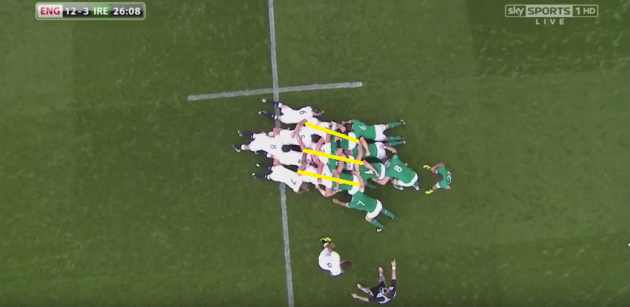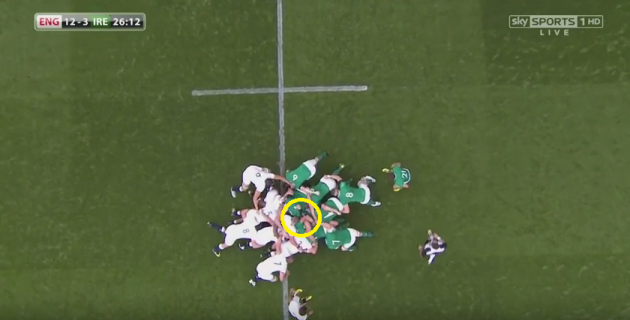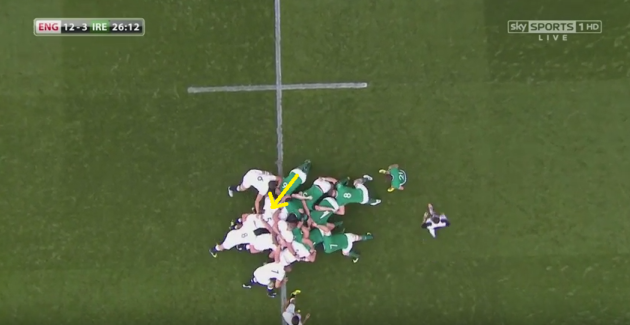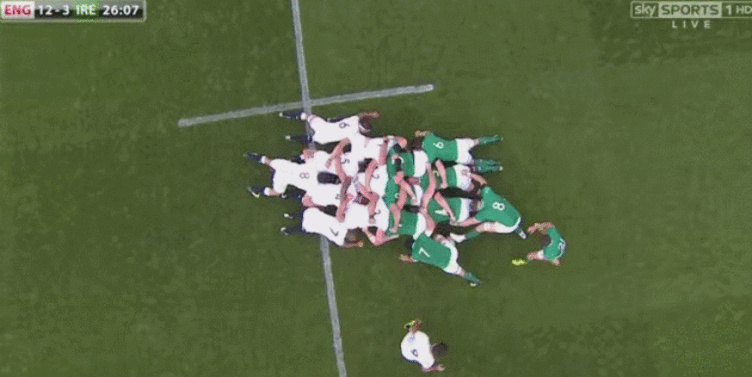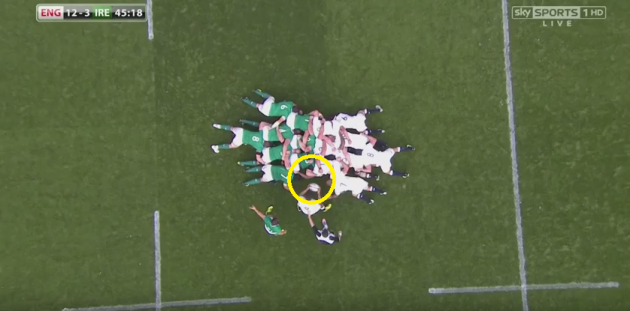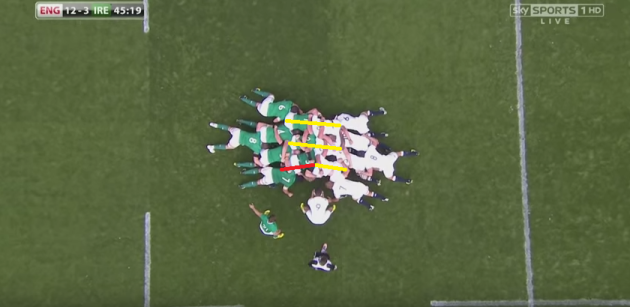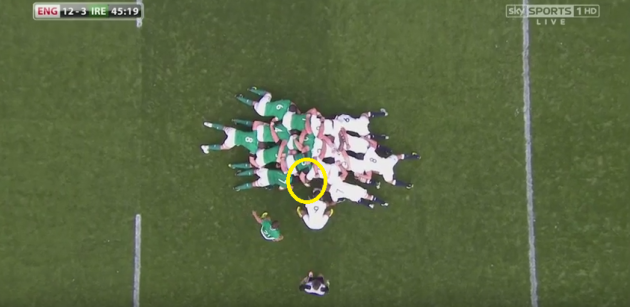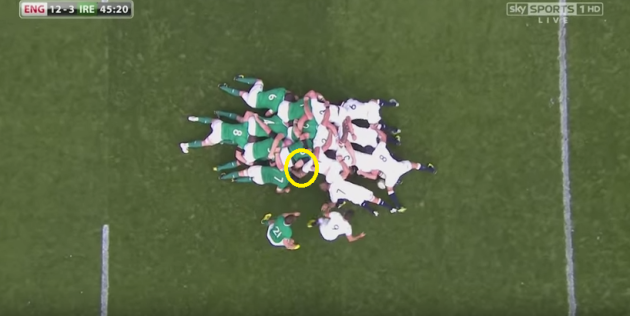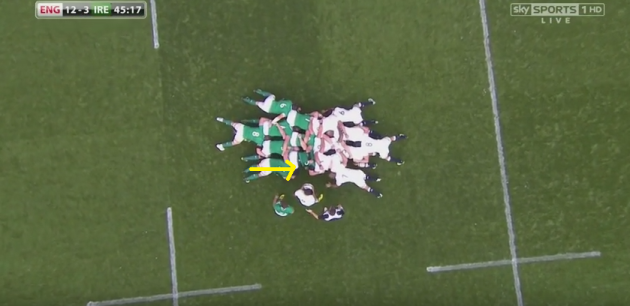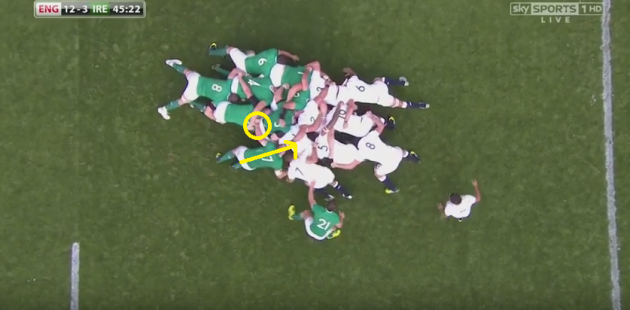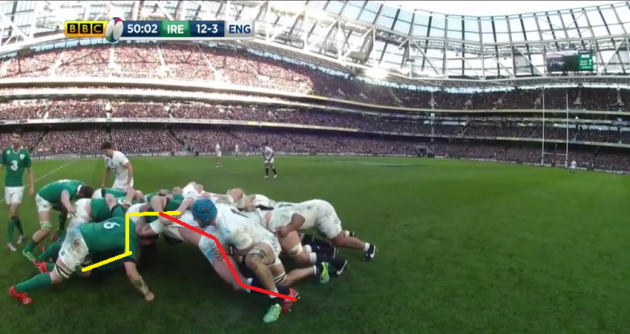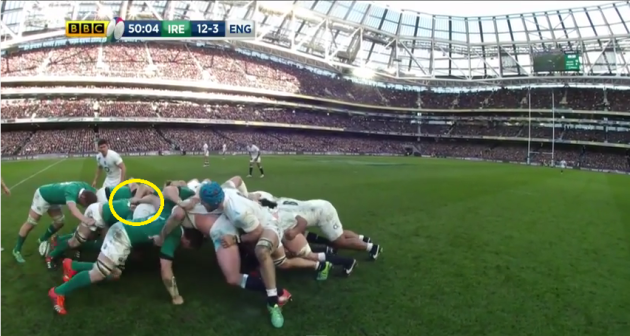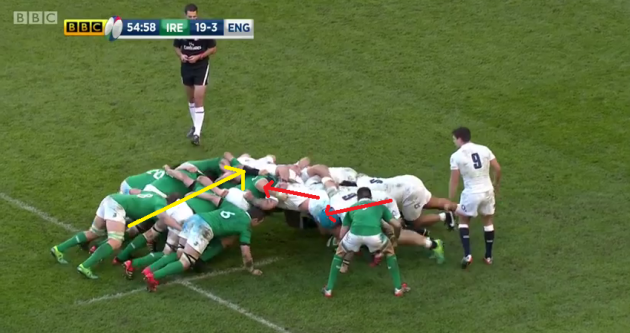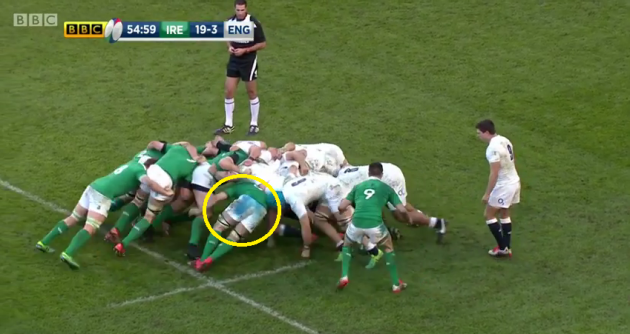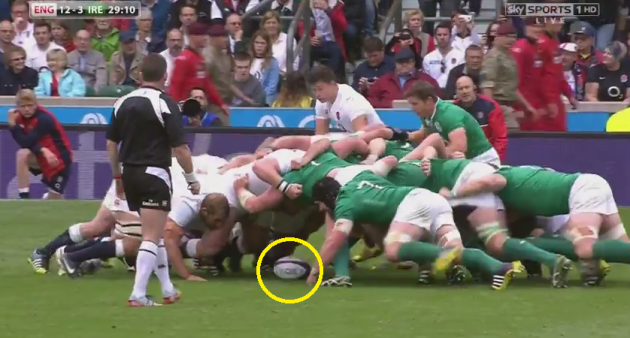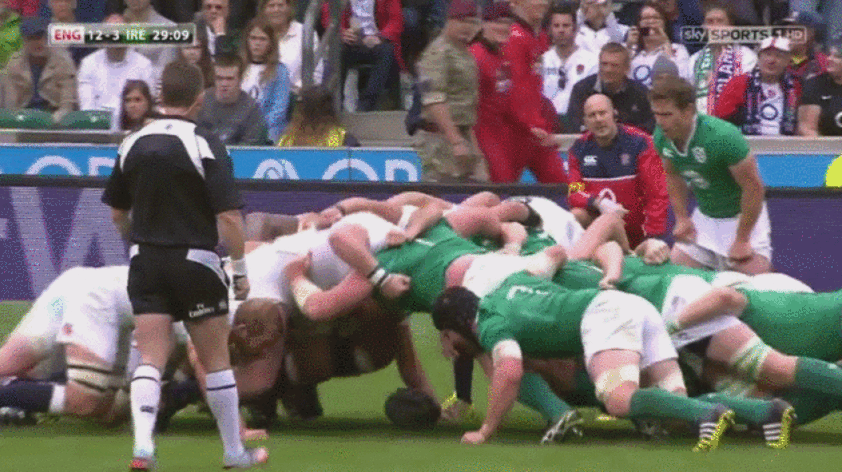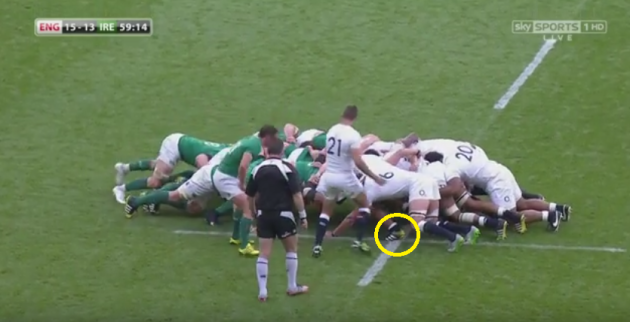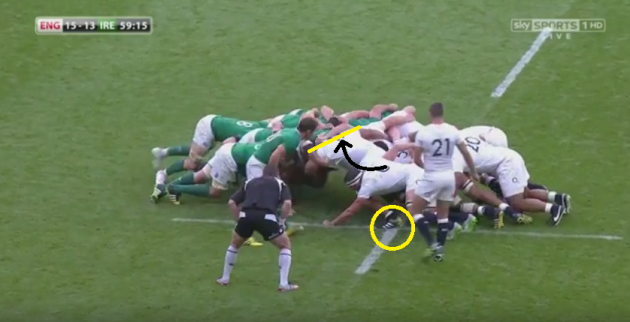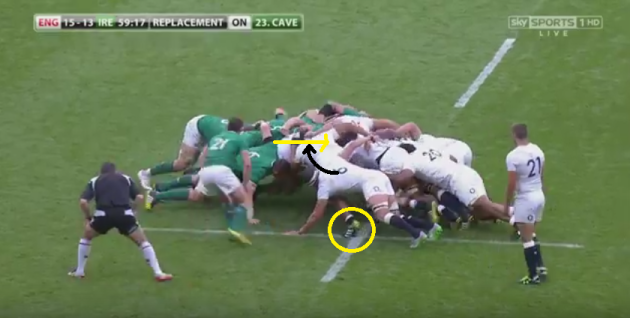WHEN YOU’RE IN control of the scrum, sometimes you start to push the limits.
After struggling at times during the Autumn Internationals last year, Ireland have enjoyed a strong 2015 at the setpiece, with the Six Nations meeting against France being the only game this season where it could be positively said that Ireland struggled.
Against England on Saturday, while Ireland didn’t dominate, they can certainly take comfort in their relative control, securing possession on all seven of their put-ins, while winning two hooks against the head, a rarity in itself in test rugby.
However, one aspect of Ireland’s scrummaging which has been of slight concern this season is the role of their flankers, who have run the risk of conceding needless penalties from shifting up the scrum and angling into the front row.
And when it’s happening in scrums that Ireland are already controlling, it’s running a risk of giving away penalties that they otherwise would have been winning.
There were two such o=instances this weekend, one where Ireland still won their penalty, and another when England had shoved Ireland backwards.
The first was around 20 minutes in, and it could have ruined what was an excellent shove by the Irish front row.
First off, we’ll look at what Ireland did well at that scrum. Here’s the initial view of the scrum, with all of the front rows lined up straight to each other. Joe Marler had got an initial shove on Mike Ross, but the tighthead would then hit back.
Once Ross found his rhythm, things started to move forward, and as we can see below, Tom Youngs, the England hooker, stood up under pressure. We can see in the circle below, how Youngs’ head has bolted up, breaking Rory Best’s bind to Ross.
At this stage, Ireland simply have to keep moving forward, and the penalty will arrive, but it’s here that Peter O’Mahony on the blindside takes an unnecessary chance. Instead of binding on Paul O’Connell and driving through the back of Ross, O’Mahony slides up the side of Ross and drives into the English frontrow, effectively acting as an auxiliary prop.
Watch the scrum roll through in the Gif below, and keep an eye on O’Mahomy at 6, as he slides up the side of Ross and angles in on Marler.
Ireland still win the penalty, but it was an unnecessary chance taken.
It was something that cropped up later in the game, this time Sean O’Brien widening the angle after Mike Ross got himself into a mess. This time though, Ireland conceded the penalty.
For reference, we’ll look at the scrum just as the ball is about to be fed, with everything looking fine. Watch where Ross is bound, which is about to change and create the problem.
However, once they engage, Ross makes an uncharacteristic error with his positioning, with his hips pointing inwards and putting England at an advantage.
With his positioning off, he’s now fighting an uphill battle in this scrum.
As the ball goes in and the pressure comes on, Ross then shifts his bind down and into an illegal position on the arm of Marler.
And a second or two after that, Ross removes his bind entirely, and begins to turn into the scrum, getting himself into trouble.
Ultimately, he has turned in too much and his power is nullified, and as the scrum whips around England are awarded the penalty.
However, we’re also going to look at Sean O’Brien at openside here, and how he slides up Ross to essentially give him a dig out and disrupt Marler.
On first viewing, he’s where he should be, one arm bound to O’Connell and one to Ross, driving through the prop.
But we can see how once Ross begins to turn and get in trouble, O’Brien slides his bind up along the prop and starts driving into the side of the scrum.
One of the problems with penalising this is the ambiguity of the laws.
Law 20.3 (f) states: “All players in a scrum, other than front-row players, must bind on a lock’s body with at least one arm prior to the scrum engagement”.
We can see that O’Brien is holding the jersey of O’Connell in the second row, but the interpretation given to the referees is that all of the arm must be bound, so that in theory the flanker’s armpit is in contact with the second row.
It’s also loosely covered in law 20.3 (g): “A flanker may bind onto the scrum at any angle, provided the flanker is properly bound. The flanker must not widen that angle and so obstruct the opposing scrum half moving forward.”
Again, it’s open to interpretation. Flankers can join the scrum at any angle, but that angle cannot change. While in these cases O’Mahony and O’Brien were not obstructing the scrumhalf as it states in the laws, referees are told that this still falls into the umbrella of “widening the angle”.
It’s something that crept up the last time Ireland and England met in the Six Nations, with Peter O’Mahony twice widening his angle and driving into the side of the scrum.
For the first instance, Ireland actually won a penalty. Marler had come in on an angle into Mike Ross, as we can see below.
But O’Mahony then slides back up the scrum and in on the prop, with his arm bound to Mike Ross rather than the second row.
And soon after it happened again. Similar to last time, the scrum was being driven sideways and was turning down the blindside.
And this time O’Mahony removed his bind completely from the scrum to slide up and drive in. This time it backfired, however, as with O’Mahony too preoccupied by the scrum, Billy Vunipola broke down the channel.
While this is something Ireland will have to be wary of moving forward, there were still plenty of positives to take, namely Jack McGrath.
It’s reached a stage now where we are no longer saying that the Leinster man is growing into test rugby; it’s now expected for him to be at that level.
The loosehead stole two scrums against the head on Saturday, each time capitalising on a poor English feed and hook.
On the first occasion, Ben Youngs (quite rightly) fed the ball straight down the channel. However, with Ireland driving well, his brother Tom never attempted the hook, and the ball drifted in between McGrath and his opponent Dan Cole.
Below we can see how the ball has traveled through the scrum, right underneath the pair.
And with the ball there for the taking, McGrath steps over it just in time to claim the ball against the head.
Later on, another overhit feed gave McGrath his second identical turnover, as he stood over the ball and claimed it back for Ireland.
We can’t see McGrath’s steal on the camera angle, so instead we’re going to look at Nathan White’s role in the drive.
Mako Vunipola gets himself in a right mess, and his poor footwork only makes things worse. Had McGrath not turned over the ball, Ireland could well have won a penalty.
With the ball having just been fed, watch where Mako Vunipola’s foot is, circled, in the picture below.
White gets a good nudge on Vunipola, but rather than adjust his footwork, Vunipola only moves his BODY inwards. Instead, he should be taking a slight step back and absorbing the pressure, leaving him in a better position to gain back that ground.
With his body too bunched up, the problem just gets worse. As we can see below, his shoulders and hips are turning in, but that left foot is in the exact same position.
And as Nathan White moves further forward, Vunipola’s shoulders and hips turn further inwards, while he still is yet to adjust his feet.
The big disappointment from Saturday was how we couldn’t see enough to get a true read of Tadhg Furlong at loosehead. While he did set down for a couple of late scrums, he had Nathan White acting as his flanker.
While White would obviously be limited as a backrow, the extra power coming through the back of Furlong was probably ideal to help settle him into the position.
He didn’t get much game-time there, but with Canada’s form looking quite poor recently, it could be a good idea to give Furlong 30 minutes at loosehead in that game, and if Ireland can kill the game off early, it would be a relatively risk-free choice.
